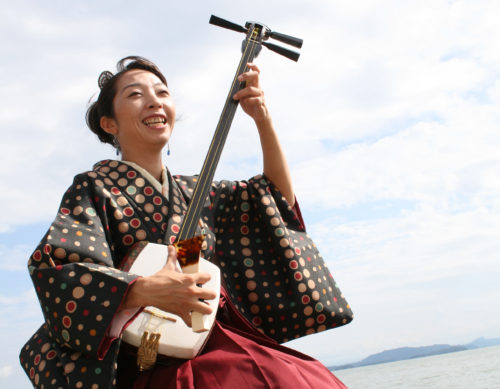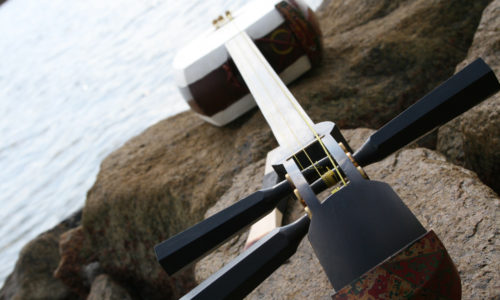1. TAWARA TSUMI uta (Aomori)
2. TSUGARU YAMA uta (Aomori) – WAIHA bushi (Aomori)
3. TAKEDA NO KOMORI uta (Kyoto)
4. HONEN bushi (Amami Oshima)
5. SHIN SOUMA bushi (Fukushima) – JONGARA kyokubiki (Aomori)
All music instruments (Tsugaru Shamisen, Shakuhachi, Singing, Sanshin, Taiko, Suzu, Hayashi)(performed by Uma Ebina ※Taiko : Japanese drum, Suzu : bell, Hayashi : meaningless words in a song for rhythm
1. TAWARA TSUMI uta (Aomori)
double Tsugaru Shamisen / Shakuhachi / Singing / Taiko / Suzu / Hayashi
“Tawara tsumi” means to load a straw bag containing 60 kg of rice into a warehouse.
Entertainers used to go door to door for the New Year to sing this song, performing “tawara tsumi” which is a symbol for good harvest. They then would receive rice and money.
2. TSUGARU YAMA uta (Aomori) – WAIHA bushi (Aomori)
TSUGARU YAMA uta
Shakuhachi
When workers entered the mountain, they used to sing to ask for permission to take plants and animals that belong to the god of the mountain. And they would also sing to pray for their own safety.
WAIHA bushi
double Tsugaru Shamisen
“Waiha” is a dialect of Aomori used to express emotions. Local people say “Waiha” when they are sad, happy or surprised.
3. TAKEDA NO KOMORI uta (Kyoto)
Tsugaru Shamisen / double Shakuhachi / Singing / Taiko
This is a lullaby transmitted in the ostracized community of Kyoto (a work song for children taking care of babies). The poor lifestyle of the children who were put out to service and the desire to return home are sung.
4. HONEN bushi (Amami Oshima)
Sanshin / Singing / Taiko / Hayashi
The folk song of Amami Oshima located in the South Seas. It was dominated by the Shimazu clan for a long time. This song is about poor lifestyle due to the harsh labor and hunger of the era.
5. SHIN SOUMA bushi (Fukushima) – JONGARA kyokubiki (Aomori)
SHIN SOUMA bushi
Tsugaru Shamisen / Singing / Taiko / Hayashi
It is said that people who left Souma (Fukushima prefecture) for work sang this song because they missed their hometown. It overlaps the present situation of people who were deprived of their hometown and were forced to evacuate due to the nuclear accident in Fukushima in 2011.
JONGARA kyokubiki
Tsugaru Shamisen
Tsugaru shamisen was the instrument that a blind man called Bosama played to survive. This is the most famous song of them all and a solo full of improvisation. In this song various rhythms and advanced techniques are frequently used.

